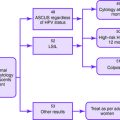Chapter 3 ADNEXAL MASS
The key element in the evaluation of an adnexal mass is whether the mass is malignant or benign. Not only can an adnexal mass represent ovarian cancer but it can also be metastatic disease from the breast or gastrointestinal tract or other gynecological neoplasms. Of all ovarian masses, 45% in postmenopausal women are cancer, in comparison with 13% in premenopausal women
Key Historical Features
✓ Family history, especially of ovarian, breast, and colon cancer
Key Physical Findings
Suggested Work-Up
| Urine pregnancy test | To evaluate for pregnancy in a woman of childbearing age |
| Transvaginal ultrasonography | According to the latest guidelines from the American College of Obstetricians and Gynecologists (ACOG), transvaginal ultrasonography is the first choice of imaging in asymptomatic women with a pelvic mass |
| Cancer antigen 125 (CA 125) measurement | Of women with epithelial ovarian cancer, 80% have an elevated CA 125 level; however, it is elevated in only 50% of women with stage 1 disease, and its measurement is therefore not a good screening test |
| In addition, CA 125 level is rarely elevated with germ cell, stromal, or mucinous ovarian cancers | |
| The sensitivity and specificity of CA 125 in diagnosing malignant adnexal masses is highest after menopause | |
| Elevation of CA 125 level in a postmenopausal woman with an adnexal mass is very suggestive of cancer | |
| Complete blood cell count (CBC) | To evaluate for anemia or infection |
Additional Work-Up
| Quantitative β–human chorionic gonadotropin (β-hCG) measurement | To evaluate for malignant germ cell tumors, especially in premenopausal women |
| α-Fetoprotein measurement | If malignant germ cell tumor is suspected |
| Lactate dehydrogenase (LDH) measurement | If malignant germ cell tumor is suspected |
| Inhibin A and inhibin B measurement | If ovarian granulosa cell tumor is suspected |
| Gonorrhea and chlamydia nucleic acid amplification tests or culture | To evaluate for gonorrhea and Chlamydia infections if suspected or if patient is at risk |
| Pap smear | If cervical cancer screening is due |
| Colonoscopy | If colon cancer is suspected or if colon cancer screening is due |
| Upper gastrointestinal endoscopy | If gastric cancer is suspected |
| Fecal occult blood testing | To evaluate for risk of colon or other gastrointestinal cancers |
| Mammography | If breast cancer is suspected or if breast cancer screening is due |
| Computed tomographic scan of abdomen and pelvis (with contrast media) | To evaluate for metastases or an unknown primary cancer |
| Endometrial biopsy | To evaluate for uterine cancer if postmenopausal uterine bleeding is present or a thickened endometrial lining is visible on ultrasonography |
| Magnetic resonance imaging (MRI) of pelvis | To evaluate pelvic masses whose ultrasound findings are indeterminate |
American College of Obstetricians and Gynecologists. ACOG Practice Bulletin. Management of adnexal masses. Obstet Gynecol. 2007;110:201-214.
Gostout BS, Brewer MA. Guidelines for referral of the patient with an adnexal mass. Clin Obstet Gynecol. 2006;49:448-458.
McDonald JM, Modesitt SC. The incidental postmenopausal adnexal mass. Clin Obstet Gynecol. 2006;49:506-516.
Russell DJ. The female pelvic mass: diagnosis and management. Med Clin North Am. 1995;79:1481-1493.




